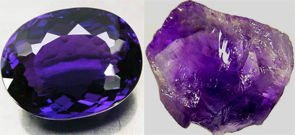 Photo of Amethyst in Processed & Rough Form
Photo of Amethyst in Processed & Rough Form
Amethyst is a mineral with a hardness of 7 out of 10 on the Mohs scale of mineral hardness [?]. These Trigonally structured gems are made of silicon dioxide, their full chemical compound being SiO2.
Amethyst is the most coveted stone in the quartz group, and it is sometimes confused with beryl. It is usually found layered with milky quartz, and its color varies from purple to violet.
It is sometimes sold as Ametrine, but this is actually a combined variation of 2 gems; Amethyst and Citrine.
Amethyst like Agate Chalcedony can be found in geodes.
There are many types of synthetic Amethyst around today, so make sure you ask before you buy.
Like Tourmaline and Tanzenite, Amethyst is often heat treated to change its hue.
A funny and strange historical fact is that Amethyst comes from the Greek word methystos which literally means not drunk. It was worn or carried in ones pockets to prevent drunkenness. :)
What is Amethyst?
Amethyst is purple quartz, ranging from light lilac to deep purple. Its color comes from irradiation of iron impurities. It's the traditional February birthstone and one of the most popular purple gemstones.
Where is it found?
Major deposits exist in Brazil, Uruguay, Zambia, and Arizona. The largest source is Brazil, while Siberian amethyst (now mostly depleted) was historically considered the finest quality.
How can I identify real Amethyst?
Look for color zoning, hexagonal crystal structure, and hardness of 7. Natural amethyst often shows color banding and is dichroic (shows different colors from different angles).
What's the historical significance?
Name means "not intoxicated" in Greek - believed to prevent drunkenness. Historically worn by royalty and clergy. Once valued as highly as ruby and emerald before large Brazilian deposits were discovered.
What determines its value?
Deep, rich purple with red flashes commands highest prices. Value depends on color intensity, clarity, and size. Natural, untreated stones are more valuable than heat-treated ones.
Natural vs. Treated?
Heat treatment can improve color or create other varieties like citrine. Most commercial amethyst is natural but may be heat-treated to enhance color uniformity. Artificial amethyst exists but is uncommon.
The specific gravity [?] for Amethyst is 2.65, its refractive index [?] is 1.54-1.55, and its double refraction [?] is 0.009.
History
Purple Amethyst has been coveted for centuries by Royalty and the Christian Church. Purple is the standard royal color, so this gemstone matches well with this scheme.
Industrial Usages
Quartz in general is used to create optics, glass, beads, circuit boards, sandpaper, and certain electronic devices.









